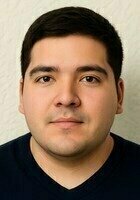All SAT Math Resources
Example Questions
Example Question #27 : Other Decimals
Which of the following represents the product of
in scientific notation?
None of these
A number in scientific notation takes the form 


To multiply two numbers that are in scientific notation, first, use commutativity to multiply the numbers:
Applying the Product of Powers Rule on the powers of 10:
However, since 

Example Question #61 : Decimals
Convert 0.0004640 into scientific notation.
The value is already in scientific notation
When written in scientific notation, a number will follow the format 


To find 
To find 




Together, the final scientific notation will be 
Example Question #62 : Decimals
If Johnny buys two comic books, priced at $1.50 each, and a candy bar, priced at $0.75, he'll have three quarters and two dimes left over. How much money does he have right now?
$3.75
$5.10
$3.20
$4.35
$4.70
$4.70
Add what he can purchase to what he has left over:
Two comic books and the candy bar: $1.50 + $1.0 + $0.75 = $3.75
Three quarters and two dimes: $0.75 + $0.20 = $0.95
Therefore his total amount of money is $3.75 + $0.95 = $4.70.
Example Question #63 : Decimals
Add:
In order to add the decimals, add placeholders to the decimal 
Be careful not to add the wrong digits!
Add the thousandths places.
Add the hundredths places.
Add the tenths places.
Combine the numbers and put a decimal before the tenths place.
The correct answer is:
Example Question #2 : How To Add Decimals

A family is taking a trip from Town A to Town B, then to Town C. Above is a diagram of the routes available to them.
Give the range for the driving distance 
None of the other choices gives the correct response.
Each route includes one path from Point A to Point B and one path from Point B o Point C.
The shortest possible drive is the sum of the shortest paths for each leg of the trip:
The longest possible drive is the sum of the longest paths for each leg of the trip:
The correct response is that 
Example Question #3 : How To Add Decimals

Above is a simplified map of the routes from Town A to Town B, and the routes from Town B to Town C.
A family wants to travel from Town A to Town C by way of Town B, then back to Town A by way of Town B. Since all routes are scenic, the family does not want to take any route twice.
Give the range for the distance 
The family's trip will be designed so that the family will take two different routes of the three that connect Town A and Town B, and two different routes of the three that connect Town B and Town C.
The minimum distance that the family will travel is therefore the sum of the lengths of the two shortest routes from Town A to Town B, and those of the two shortest routes from Town B to Town C:

The maximum distance that the family will travel is, similarly, the sum of the lengths of the two longest routes from Town A to Town B, and those of the two longest routes from Town B to Town C:

The correct choice is therefore 
Example Question #4 : How To Add Decimals

A family is taking a trip from Town A to Town B, then to Town C. Above is a diagram of the routes available to them. How many routes will only require them to drive 40 miles or fewer:
Five
Six
Two
Three
Four
Five
There are three routes from Point A to Point B, and three from Point B to Point C, for a total of 
Five of these routes require driving a distance 40 miles or fewer.
Example Question #411 : Arithmetic
Round the answer to the nearest tenth.
0.57 - 2.657 = -2.087
Don't forget the negative sign!
This number then rounds to -2.1.
Example Question #4 : Decimals
45.728 x 3.2 = ?
14.63296
14632.96
146.3296
1463.296
146329.6
146.3296
Multiply the numbers out in long format, then move the decimal point over the total number of decimal points in the two numbers (3 in the first, 1 in the second, so 4 total):
45.728 * 3.2 = 91456
91456 + 1371840 = 1,463,296 → 146.3296
Or just count the decimal points in the answer and make sure it's 4.
Example Question #1 : Decimal Operations
At the farmer's market, oranges are $0.30 each, apples are $0.25 each, bananas are $0.40 each, and tomatoes are $0.60 each. If Scott buys 3 oranges, 7 apples, 4 bananas, and 8 tomatoes, how much does he spend?
$10.40
$11.40
$9.05
$6.80
$7.75
$9.05
To find out how much Scott spends, we need to multiply the quantity of each fruit by its price and add them all up.
3 * $0.30 + 7 * $0.25 + 4 * $0.40 + 8 * $0.60 = $9.05
All SAT Math Resources




























































